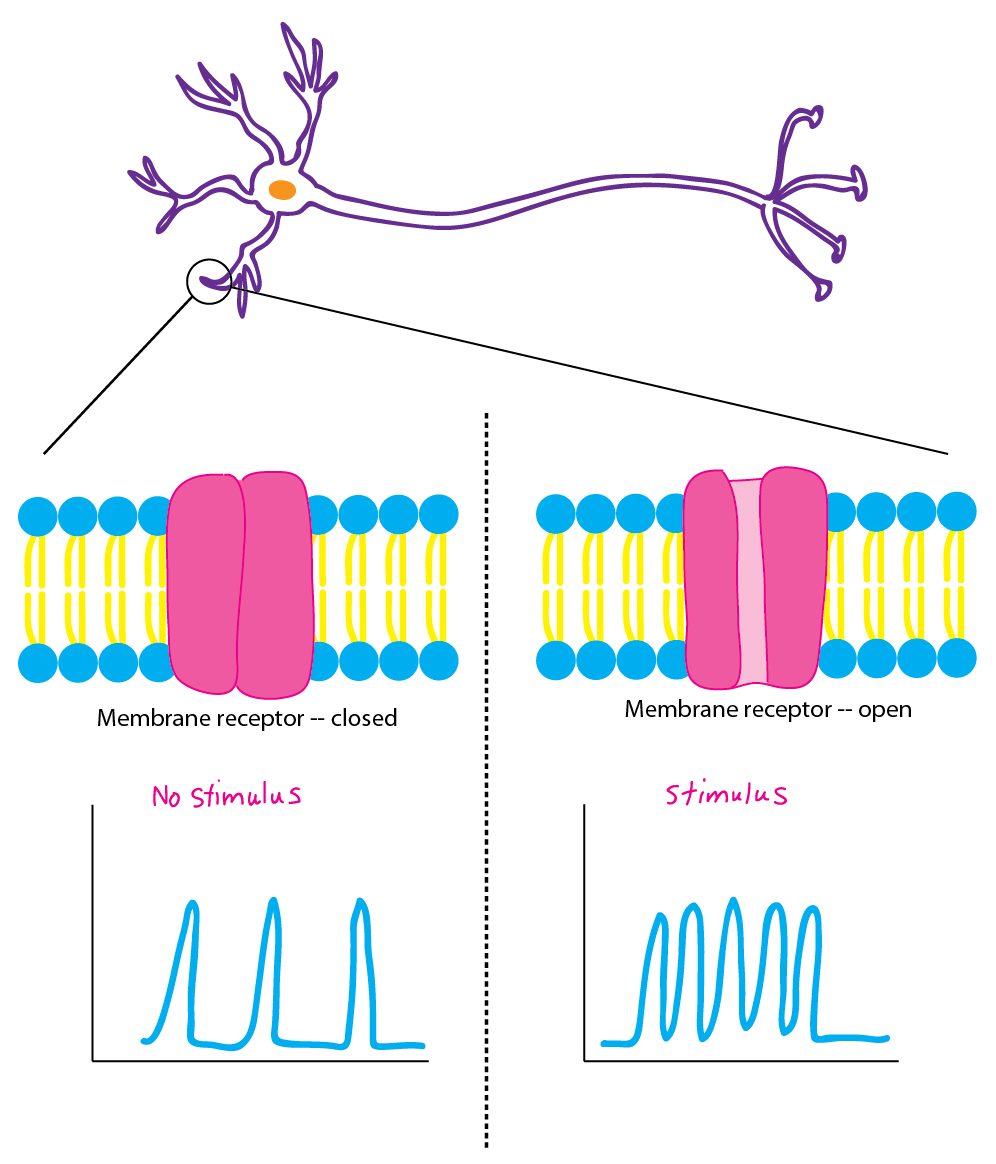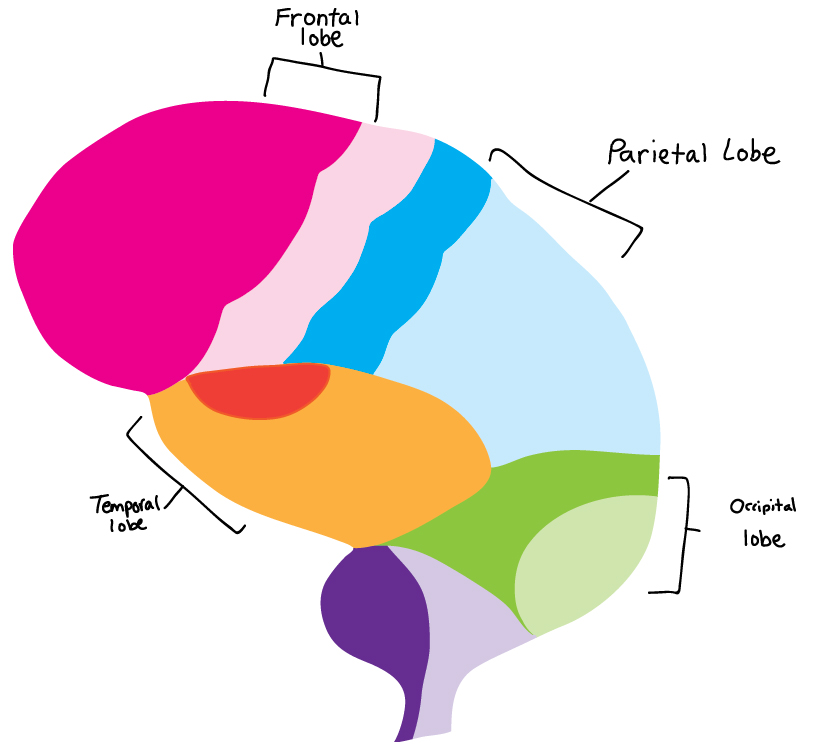CHAPTER SUMMARY
36.1 ANIMAL SENSORY RECEPTORS DETECT PHYSICAL AND CHEMICAL STIMULI BY CHANGES IN MEMBRANE POTENTIAL.
- Sensory neurons include chemoreceptors, mechanoreceptors, thermoreceptors, pain receptors, and electromagnetic receptors.
- Action potential firing rate correlates with the strength of a stimulus. Generally, strong stimuli induce high firing rates and weak stimuli induce low firing rates.
- Animal sensory receptors increase their sensitivity to stimuli by temporal and spatial summation, enhance their acuity by lateral inhibition, and adapt to continuous stimuli.
36.2 SPECIALIZED CHEMORECEPTORS RELAY INFORMATION ABOUT SMELL AND TASTE.
- Odorant molecules bind to membrane receptors on the surface of olfactory chemoreceptors.
- In humans, five taste receptors—for sweet, bitter, sour, salty, and savory—are activated in combination to determine a specific taste.
36.3 HAIR CELLS CONVEY INFORMATION ABOUT MOVEMENT AND SOUND.
- Hair cells are specialized mechanoreceptors that detect motion and vibration.
- The statocysts of invertebrates are sensitive to gravity, orienting an organism to “up” and “down.”
- The vestibular system of the vertebrate ear provides a sense of balance and gravity.
- The tympanic membrane in the outer ear transmits airborne sound waves to the middle ear, where the signal is amplified, and then to the cochlea in the inner ear, where sound waves are converted to fluid pressure waves and then sensed by hair cells that convert the signal to an electrical impulse.
36.4 THE ABILITY TO SENSE LIGHT AND FORM IMAGES DEPENDS ON PHOTOSENSITIVE CELLS WITH LIGHT-ABSORBING PROTEINS.
- The protein opsin present in photoreceptors converts light energy into chemical signals, altering the firing rate of neurons they inhibit or stimulate.
- The eyecups of flatworms detect light and dark.
- The compound eyes of arthropods sense light using individual light-focusing elements called ommatidia, providing low acuity but rapid motion detection.
- The single-lens eyes of vertebrates and cephalopod mollusks focus images on a retina, which contains photoreceptor cells and interneurons that process the light stimuli.
- Photoreceptor cells of the retina include rod cells, which detect light but not color, and cone cells, which detect color.
- Photoreceptor cells, bipolar cells, ganglion cells, horizontal cells, and amacrine cells form a network that processes visual information in the retina.
36.5 THE BRAIN PROCESSES AND INTEGRATES INFORMATION FROM MULTIPLE SENSORY SYSTEMS, WITH TACTILE, VISUAL, AND AUDITORY STIMULI MAPPED IN THE CEREBRAL CORTEX.
- The vertebrate brain is organized into a hindbrain, midbrain, and forebrain, with the forebrain elaborated into the cerebral cortex in birds and mammals.
- The brain is divided into frontal, parietal, temporal, and occipital lobes that are specialized for different functions.
- Somatosensory, motor, auditory, and visual information is topographically mapped to specific areas in the cerebral cortex.
36.6 COGNITION IS THE ABILITY OF THE BRAIN TO PROCESS AND INTEGRATE COMPLEX SOURCES OF INFORMATION, TO REMEMBER AND INTERPRET PAST EVENTS, TO SOLVE PROBLEMS, TO REASON, AND TO FORM IDEAS.
- The cerebral cortex integrates and processes information from diverse sources, giving rise to problem solving, reasoning, and decision-making.
- The brain stores memories of past experiences and enables learning through the creation of more permanent neural circuits.
- Consciousness is an awareness of one’s own identity in relation to others.
Self-Assessment Question 1
Give an example of a chemosensory neuron, a mechanosensory neuron, and an electromagnetic sensory neuron.
Show Model Answer
Model Answer:
Chemoreceptor neurons respond to molecules that bind to specific protein receptors on the cell membrane of the sensory receptor. The interaction of molecules and chemoreceptors underlies the sense of smell and taste. An example is coral polyps responding to concentrations of simple amino acids in water to feed.
Mechanosensory neurons respond to physical deformations of their membrane that can be caused by touch, stretch, pressure, motion, and sound. Examples are the receptors in our skin that sense touch and pressure.
Electromagnetic sensory neurons respond to electrical, magnetic, and light stimuli. Examples are the photoreceptors that sense light in different organisms.
Self-Assessment Question 2
Diagram a generalized receptor neuron, showing how it changes its firing rate in response to detected stimuli.
Show Model Answer
Model Answer:

Self-Assessment Question 3
State a hypothesis that explains why all animals have chemoreceptors.
Show Model Answer
Model Answer:
All animals have chemoreceptors so they can sense food sources.
Self-Assessment Question 4
Describe the three main stages by which sound is detected and coded by the mammalian ear.
Show Model Answer
Model Answer:
The three main stages by which sound is detected and coded by the mammalian ear are as follows: (1) Amplification: sound vibrations are amplified by the bones in the middle ear. The vibrations are then transmitted to the oval window of the cochlea in the inner ear. (2) Transfer of sound vibration to fluid pressure waves: vibrations of the oval window cause fluid pressure waves in both canals of the cochlea at the same time. (3) Mechanoreception by hair cells within the cochlea: fluid vibrations within the cochlear canals bend the stereocilia of the hair cells back and forth, stimulating them to release excitatory neurotransmitters. These cause postsynaptic neurons to fire action potentials that are sensed as sound by neuronal networks in the brain.
Self-Assessment Question 5
Compare and contrast the roles of rod cells and cone cells in the retina.
Show Model Answer
Model Answer:
Cone cells have color-sensitive pigments that allow the eye to detect color. Rod cells, which are differently shaped, sense light but not color. Rod cells can detect white, to shades of grey, to black. Because of their greater number and sensitivity to light, rod cells enable animals to see in low light. Cone cells predominate in the center of the retina while rod cells predominate the periphery.
Self-Assessment Question 6
Describe the role of the cornea and lens in vertebrate eyes.
Show Model Answer
Model Answer:
The cornea is the transparent part of the sclera in the front of the eye. Light passes through the cornea before reaching the lens. The cornea and lens bend incoming light rays, focusing them on the retina at the back of the eye to form images.
Self-Assessment Question 7
Describe three different types of eye in animals.
Show Model Answer
Model Answer:
Three different types of eyes in animals are eyecups, compound eyes, and single lens eyes. (1) Eyecups sense the direction and intensity of light but do not form images. Eyecups contain photoreceptors that point up and to the left or right. A pigmented epithelium layer is behind the photoreceptors so that eyecups only sense light from above and in front of the animal. (2) Compound eyes are made up of multiple light-focusing elements, each with a lens, called ommatidia. Ommatidia individually focus light onto a central region formed from multiple overlapping photoreceptors. Compound eyes provide a mosaic image and extremely good at detecting motion and flashes of light. (3) Single-lens eyes produce a sharply defined image of the animal’s visual field. A single lens focuses light rays on a particular region of photoreceptors, improving image quality and light sensitivity.
Self-Assessment Question 8
Draw the brain, label the lobes, and describe their primary functions.
Show Model Answer
Model Answer:

The frontal lobe is important in decision making and planning. The parietal lobe controls body awareness and the ability to do complex tasks. The occipital lobe processes visual information, and the temporal lobe processes sound.
Self-Assessment Question 9
Describe the importance of topographic mapping of sensory input to the cortex, using the primary somatosensory cortex as an example.
Show Model Answer
Model Answer:
Neurons in the primary somatosensory cortex integrate tactile information from specific body regions. The area of the body that is sensed by particular sensory neurons in the skin can be mapped onto the cortex. Thus, if an injury occurs in a specific area of the brain, you might be able to predict which areas of the body may be most affected. For example, an injury in one region of the somatosensory cortex might affect your touch sensation in part of your arm.
Self-Assessment Question 10
Explain how brain function can be understood by studying patients with brain injuries.
Show Model Answer
Model Answer:
By correlating the area of the brain affected with the effects of the injury, you may be able to tell which functions or body areas that part of the brain controls. For example, if a person has an injury in a particular part of their brain and their sense of taste changes, there is a good probability that that area controls taste perception.